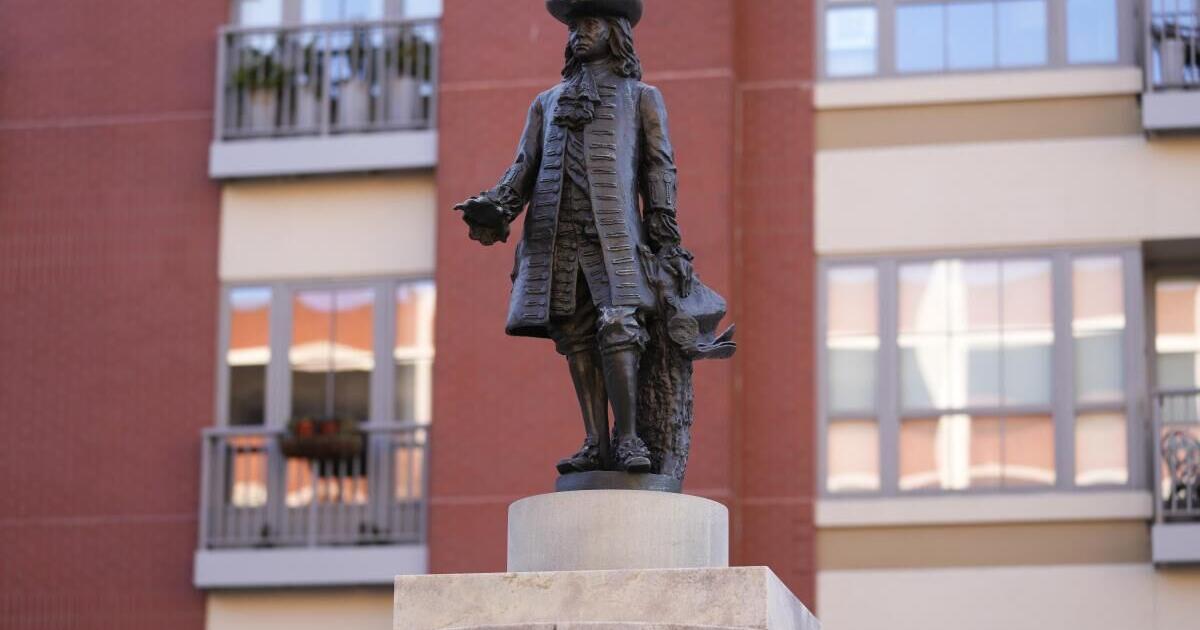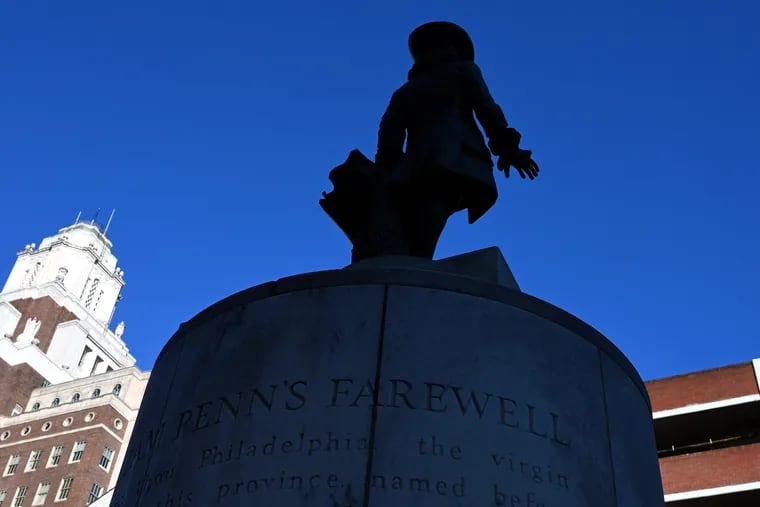Access to this page has been denied a human (and not a bot).Press & HoldPlease check your network connection or disable your ad-blocker.’; document.body.appendChild(div); }; ]]>
Continue reading
Tag: Lenni Lenape
Access to this page has been denied
Access to this page has been denied a human (and not a bot).Press & HoldPlease check your network connection or disable your ad-blocker.’; document.body.appendChild(div); }; ]]>
Continue reading
Access to this page has been denied
Access to this page has been denied a human (and not a bot).Press & HoldPlease check your network connection or disable your ad-blocker.’; document.body.appendChild(div); }; ]]>
Continue reading
Access to this page has been denied
Access to this page has been denied a human (and not a bot).Press & HoldPlease check your network connection or disable your ad-blocker.’; document.body.appendChild(div); }; ]]>
Continue reading

HARRISBURG, Pa. – The National Park Service’s proposal to remove a William Penn statue from a historic site in Philadelphia –- quickly withdrawn amid a backlash — wasn’t a priority for some of the Native Americans the agency was required to consult with as it prepared to renovate the deteriorating plaza.
Uprooting the statue of Pennsylvania’s founder from Welcome Park also wasn’t a major point of discussion as park service officials and tribal representatives met to plan the renovation over video last year, said Jeremy Johnson, director of cultural education for the Delaware Tribe of Indians.
Rather, what tribal representatives had envisioned for the plaza is an exhibit that would highlight the culture, history, traditions and perceptions of the Native Americans who had lived there for thousands of years before Penn arrived, Johnson said.
“We do still speak highly of William Penn,” Johnson said. But tribal representatives, he said, “were really just focusing on our culture and our history and that, in a way, he was an important part of it, but … it was a small interaction compared to our overall history.”
A park service spokesperson hasn’t responded to repeated questions about the abandoned proposal.
Announced quietly on Friday, the plan quickly and — perhaps unexpectedly — laid bare the sensitivities around the image of the colonial founder of Pennsylvania and threatened to become the latest front in a fight over how to tell the nation’s history through its monuments.
A top state Republican lawmaker, Bryan Cutler, said removing Penn’s statue to “create a more inclusive environment takes (an) absurd and revisionist view of our state’s history.” Democratic Gov. Josh Shapiro pressed the Biden administration to keep the statute in its “rightful home.”
The park service said it consulted with representatives of the Haudenosaunee, the Delaware Nation, Delaware Tribe of Indians, the Shawnee Tribe, and the Eastern…



1/38
High School Swimming: Super Essex County High School Swimming Championships on January 15, 2024Subscribers can gift articles to anyone
ESSENTIAL LINKS
Monday, Jan. 15
BIG NORTH
Indian Hills 118, Ramapo 48 – Box Score
CAPE-ATLANTIC
Ocean City 136, Lenape 33 – Box Score
CVC
Robbinsville 110, Hightstown 60 – Box Score
Steinert 107, Hamilton West 55 – Box Score
NJAC
Morris Knolls 108, Roxbury 62 – Box Score
SHORE
Toms River South 114, Toms River North 55 – Box Score
SJSL
Ocean City 136, Lenape 33 – Box Score
Monday, Jan. 15
BIG NORTH
Ramapo 102, Indian Hills 28 – Box Score
CAPE-ATLANTIC
Ocean City 89, Lenape 81 – Box Score
CVC
West Windsor-Plainsboro South 96, Ewing 43 – Box Score
Robbinsville 101, Hightstown 67 – Box Score
Steinert 103, Hamilton West 67 – Box Score
NJAC
Roxbury 109, Morris Knolls 61 – Box Score
SJSL
Ocean City 89, Lenape 81 – Box Score
If you purchase a product or register for an account through a link on our site, we may receive compensation. By using this site, you consent to our User Agreement and agree that your clicks, interactions, and personal information may be collected, recorded, and/or stored by us and social media and other third-party partners in accordance with our Privacy Policy.
Access to this page has been denied
Access to this page has been denied a human (and not a bot).Press & HoldPlease check your network connection or disable your ad-blocker.’; document.body.appendChild(div); }; ]]>
Continue reading

[] Please subscribe to keep reading. You can cancel at any time.
Subscription services is currently down for maintenance. Please check back later.]]>
‘; } else { var sFallBack = ‘Click here to subscribe‘; } $(‘#lee-services-list .loading’).hide(); $(‘#lee-services-list’).html(‘[]’+sFallBack+’
‘); $(‘.lee-featured-subscription’).html(sFallBack); } function lee_formatPackage(oService){ try { var bOnlyModal = true; var oSettings = lee_getPackageSettings(oService.HomeMembership); var newService = {}; if(parseInt(oService.WebFeatureFG) === 2) return false; if(oService.WebStartPrice != ”){ var custom = JSON.parse(oService.WebStartPrice); $.each(custom, function(k,v){ newService[k] = v; }); } if(bOnlyModal && newService.in_modal && newService.in_modal.toLowerCase() === ‘false’) return false; if(!bOnlyModal && newService.not_members && newService.not_members.toLowerCase() === ‘true’) return false; newService.has_featured_class = newService.featured ? ‘featured-package’ : ”; newService.sort = parseInt((newService.sort) ? newService.sort : oSettings.sort); newService.title = (newService.package_title && newService.package_title != ”) ? newService.package_title : oSettings.title; newService.level = oService.HomeMembership; newService.html = oService.WebOfferHTML; newService.disabled = newService.disable_purchase ? ‘disabled’ : ”; var price = lee_formatPackagePrice(newService.start_price); newService.start_price = price.cost; newService.format_dollars = (price.format_dollars) ? price.format_dollars : ”; newService.format_cents = (price.format_cents) ? price.format_cents : ”; newService.start_at_rate = (newService.fixed_rate === ‘true’) ? ‘for the low price of’ : ‘starting at’; if( !newService.term ) newService.term = ‘per month’; newService.has_promotion_class = ”; if( newService.promotional_price && newService.promotional_price != ” ){ newService.has_promotion_class = ‘has-promotion’; var promotion = lee_formatPackagePrice(newService.promotional_price); newService.promotional_price = promotion.cost; newService.promotional_format_dollars = (promotion.format_dollars) ? promotion.format_dollars : ”; newService.promotional_format_cents = (promotion.format_cents) ? promotion.format_cents : ”; } newService.banner_class = ”; if( newService.banner && newService.banner != ” ){ newService.banner_class = ‘has-banner’; } newService.description = (newService.description) ? newService.description : ”; newService.special_title_class = newService.special_title ? ‘has-special-title’ : ”; newService.special_label_class = newService.label ? ‘has-label’ : ”; newService.action_button…
Continue reading
Access to this page has been denied
Access to this page has been denied a human (and not a bot).Press & HoldPlease check your network connection or disable your ad-blocker.’; document.body.appendChild(div); }; ]]>
Continue reading

On Friday, the National Park Service sought public input on initial renovation plans for Philadelphia’s Welcome Park, located at Second Street and Sansom Walk. On Monday, the park service revoked its invitation after its proposal — which suggested the removal of a small William Penn statue and adding an “expanded interpretation of the Native American history of Philadelphia” — set off a national barrage of commentary.
I unequivocally support the park service’s move toward a redesign of the park’s current interpretation — statue or no statue. As an artist, I dedicated five years of research to Welcome Park, creating a site-specific performance/tour that spoke directly to the statue in question and surrounding design — what it does and doesn’t do.
I detail this not to claim the capital “T” Truth, but to provide my context and perspective in the rigamarole of this news cycle that will flame and die.
I’d like to address concerns and interpretations showing up repeatedly from politicians, newscasters, and across social media platforms, and move the “dialogue” around this Penn statue beyond the current fixation of removal vs. no removal.
Here are some misconceptions about what removing Penn’s statue from Welcome Park means.
We erase his role from history
William Penn deserves his place in Philadelphia’s story. He has one, many times over. Even if his statue were removed from Welcome Park, his icon would not be canceled; it’s ever-present.
Have you seen Penn’s statue atop City Hall? It’s more than 36 feet tall. What about the one at Penn Treaty Park? Oh, and how about the one outside Penn Hospital, which, coincidentally, is named after him, just like the state of Pennsylvania?
To claim the removal of one infrequently visited replica installed in 1982 is erasure or trying to “cancel William Penn out of whole cloth” (according to Republican…